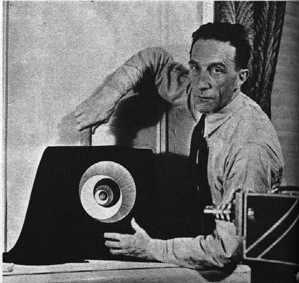Rotation of adequate figures creates a three-dimensional illusion. It can take some time until the percept emerges. In the example on the right, envisaging a rotating crater may help.
The kinetic depth effect (KDE) is a related phenomenon.
Musatti CL (1924) Sui fenomeni stereocineti [On the stereokinetic phenomenon]. Archivio Italiano di Psicologia, 3:105–120 [first scientific report on the stereokinetic illusion, attributing the discovery and name to his teacher Vittorio Benussi]
The French artist Marcel Duchamp (1887–1968) experimented with stereokinetic depth in 1935 [after: Duchamp – A Biography (1996) Tomkins C, Henry Holt & Co · New York, p 101]
Wallach H, O’Connell DN (1953) The kinetic depth effect. J Exp Psychol 45:205–217
Mather G (1989) Early motion processes and the Kinetic Depth Effect. Quarterly J Exp Psychol 41:183–198
Proffitt DR, Hecht H, Rock I, Schubert J (1992). Stereokinetic effect and its relation to the kinetic depth effect. J Exp Psychol Hum Percept Performance 18:3–21
→Beautiful: “Making Sense of Marcel Duchamp” by Andrew Stafford.
Doesn’t exist any more, see Marcel Duchamp and Andrew Stafford,
→this is somewhat of a replacement

Marcel Duchamp, Rotorelief 1949.
From Robert Lebel, “Marcel Duchamp”,
NY: Grove Press, 1959, fig. 40.